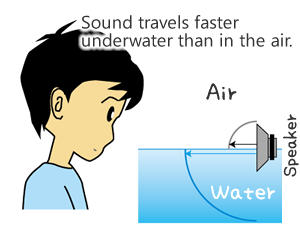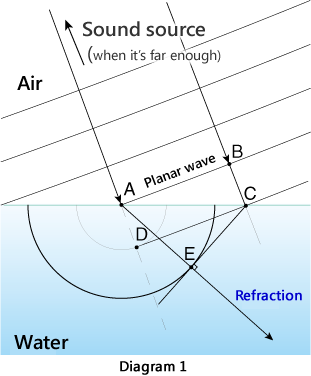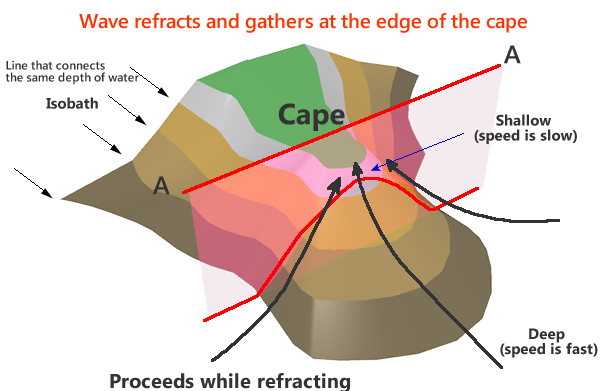- HOME
- Ono Sokki's Patio
- Refraction of Sound and Wave

Refraction of Sound and Wave
Ken: At the campsite near the ocean where I went for summer vacation, there was a sign that said "Tsunami wave will become higher at the cape. Do not stay near the cape when a tsunami warning is issued". There was no reason, so everyone was wondering why the cape is dangerous.
Dad: Didn't I teach you about the refraction of a wave?
Ken: Refraction? I have learned about the refraction of light by lens at school, but is there a relationship between the wave refraction and tsunami becoming higher at the cape?
Dad: There is a relation. I'll explain how the refraction occurs, taking the cases of sound we always talk about as an example.
Ken: Sound refracts too?
Dad: Yes. But it's difficult to experience the sound refraction phenomenon. The sound travels in air and also in water, and you know this by hearing sounds underwater when you are swimming in a pool.
Ken: I have heard from you before that sound travels
several times faster in water.
Dad: Yes. That's where it's important.
Ken: What? Is there a relation between sound refraction and difference in speed of sound in air and water?
Dad: Yes. When sound enters the water from air or from water to air, a refraction phenomenon occurs. This is because there is a difference in speed of sound between these mediums.
Ken: I don't really understand it.
Dad: I'll explain by
drawing a diagram (Diagram 1). 
First, let's think of when the sound enters the water from air, which
then refracts and travels in the water. Basically, the sound is
spherical waves from a sound source (wave source), where the wave
surface spreads spherically; but when the sound source is far enough or
if you think of a small portion of the wave surface, the wave can be
thought of as a plane (plane wave).
This diagram illustrates a situation from when a sound arrives at point
A on the water surface until point B, which is on the same wave as A,
travels to point C on the water surface. If the propagation velocity of
underwater and air were the same, point A travels to point D and no
refraction would occur. In reality, underwater propagation velocity is
faster than air. So while point B travels to point C, point A travels
longer. As it travels as a spherical wave, from the relations of circle
and tangent line, point A travels to point E as shown in the diagram.
Ken: Is it the same with light?
Dad: Yes. When you put a stick in the water, it looks bent. Light and sound are waves as well, so a refraction phenomenon occurs the same way.
Ken: I see. I somewhat understand that the refraction is caused by the difference in speed of wave transmitting in different mediums. But how do higher concentration of tsunami waves at the cape relate with the wave refraction?
Dad: Um, other than the case described before, even in the same medium, in the air for example, if the regional temperature difference is large, the wave transmitting speed will change, and therefore the refraction will occur. Similarly, if the speed of wave varies in the water, a refraction will occur.
Ken: Waves in the water changes speed; how does it happen?.
Dad: The speed of tsunami waves is influenced by the depth of the ocean. Shallower the water depth, the speed of tsunami becomes slower.
Ken: I am starting to get it. The cape and ocean depth is related.
Dad: Lines
connecting the same depth from water surface to seafloor is called
isobath, which is the same idea as the Earth's contour line. Imagine the
isobaths around the cape. If the geographical feature is normal like  this diagram (Diagram 2) where the cape is tongue shaped and the
isobaths is drawn along it, at horizontal line A, the depth of water is
shallower when it's closer to the cape. The waves there move slower, so
refracting waves are gathered to the cape.
this diagram (Diagram 2) where the cape is tongue shaped and the
isobaths is drawn along it, at horizontal line A, the depth of water is
shallower when it's closer to the cape. The waves there move slower, so
refracting waves are gathered to the cape.
Ken: I see, I understand now. I am going to explain to my classmates. I wonder if the teacher knows.
- © ONO SOKKI CO., LTD. 1996-2025
